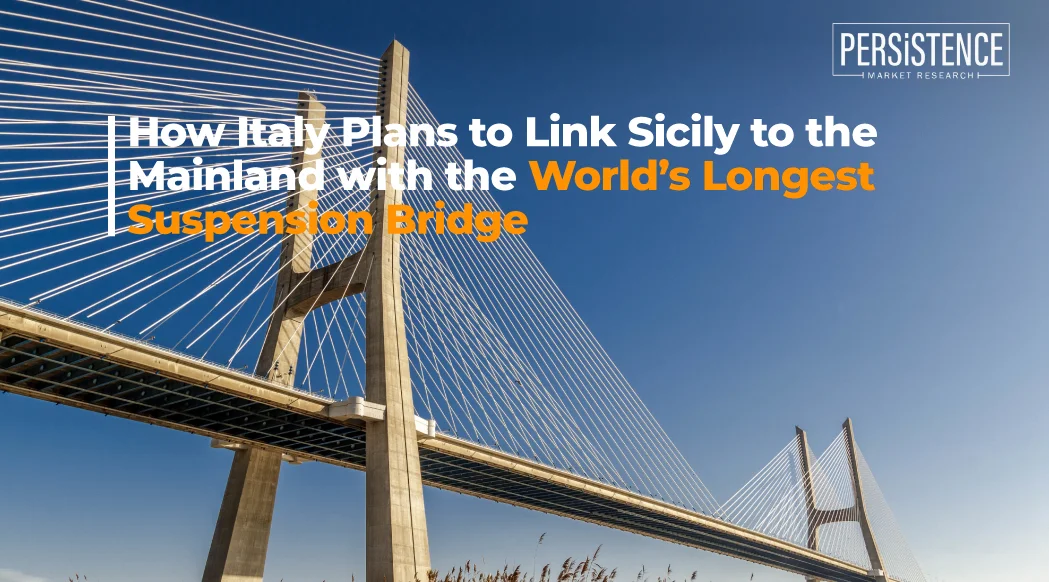- Blog
- World Longest Suspension Bridge Innovation
How Italy Plans to Link Sicily to the Mainland with the World’s Longest Suspension Bridge
Published On : 14 Aug 2025
Italy is on the brink of creating one of the most audacious engineering projects of the 21st century - a suspension bridge that will link the island of Sicily with the Italian mainland across the Strait of Messina. This ambitious structure, with a planned main span of 3,300 meters and a total deck length of 3,666 meters, is set to shatter existing world records, surpassing Turkey’s 1915 Çanakkale Bridge by more than 60% in length. For Italy, the bridge is more than a record-setter; it is the culmination of decades of political debate, engineering innovation, and strategic vision.

The Strait of Messina is a challenging waterway. With strong tidal currents, unpredictable winds, and a history of seismic activity, the site presents a natural gauntlet for bridge design. The 1908 Messina earthquake, one of the deadliest in European history, still serves as a stark reminder of the region’s seismic volatility. Building here demands engineering solutions that can withstand not only the day-to-day forces of nature but also the rare and devastating extremes. The planned bridge will rely on four colossal main cables, each over a meter in diameter, anchoring a 60-meter-wide deck that can carry three lanes of road traffic in each direction alongside two railway tracks. Wind tunnel testing has shown the deck to be stable in gusts up to 270 km/h, well beyond the highest winds recorded in the area, while advanced seismic isolation systems are designed to absorb the shock of major earthquakes.
Once completed, the bridge promises to radically alter transportation across southern Italy. Today, the crossing between Sicily and the mainland depends on ferries, which, while picturesque, are often slow, crowded, and subject to weather-related delays. The new bridge will allow high-speed trains to travel directly from mainland Europe into Sicily, cutting journey times and eliminating the cumbersome process of loading trains onto ferries. Road traffic will also benefit from uninterrupted 24/7 access, with the capacity to handle up to 6,000 vehicles per hour and 200 trains per day. This connectivity is expected to transform regional mobility, making Sicily an integral part of the European high-speed rail network and a more competitive hub for trade.
Economically, the stakes are enormous. The project, estimated to cost between €13.5 and €15.6 billion, is projected to generate over 100,000 jobs during construction and deliver a GDP boost exceeding €23 billion over the coming decades. It also completes a critical missing link in the EU’s Trans-European Transport Network, connecting the Scandinavian-Mediterranean corridor and solidifying Italy’s role as a Mediterranean logistics powerhouse. Beyond economics, Italian authorities have underscored the bridge’s strategic value, positioning it as a key piece of infrastructure for both civilian and emergency use.
Yet, the project is not without fierce opposition. Environmental groups have raised concerns about potential damage to marine ecosystems, bird migration patterns, and coastal landscapes. Much of the connecting infrastructure will require new tunnels and roadways, sparking fears of habitat fragmentation and increased urban sprawl. Local communities have voiced anger over property expropriations, while skeptics worry about cost overruns, delays, and corruption risks. Protests in Messina this summer drew thousands, a reminder that while the bridge may be a national vision, it is also a deeply local issue.
If construction proceeds as planned, major works will begin in 2026, with completion expected by 2032 or 2033. If Italy succeeds, the Messina Bridge will not only be the longest suspension bridge ever built but also a defining symbol of engineering prowess, resilience, and ambition. It would stand as a physical and symbolic connection - knitting Sicily into the heart of Europe and overcoming a natural barrier that has separated the island from the mainland for millennia.
Industry Report

Request Report Sample
Your privacy is important to us; your data is secure
Contact Us
Latest Reports
-
Piezoresistive Pressure Sensor Market by Sensor Type (Absolute, Gauge, Differential, Sealed), Pressure Range (Low Pressure (<10 kPa), Medium Pressure (10 kPa – 1000 kPa), High Pressure (>1000 kPa)), End-Use Industry (Automotive & Transportation, Industrial Manufacturing, Healthcare, Aerospace & Defense, Electronics) and Regional Analysis for 2026-2033
-
Aquarium Accessories Market by Product Type (Filtration Items, Lights & Hoods, Temperature Control Systems, Others), End-User (Residential, Commercial), Distribution Channel (Online, Offline), and Regional Analysis for 2026-2033
-
Oxygen Therapy Market by Product Type (Compressed Oxygen, Concentrated Oxygen, Liquid Oxygen), Disease (Respiratory Disorder, Cardiovascular Disease, Sleep Apnea, Pneumonia), End-User (Hospitals, Home Healthcare, Clinics), and Regional Analysis for 2026-2033
-
Air Curtains Market by Product Type (Non‑Recirculating, Recirculating, Heated, Others), Airflow Capacity (Up to 500 m³/h, 500–1000 m³/h, 1000–1500 m³/h, Above 1500 m³/h), Application (Commercial, Industrial, Residential, Others), and Regional Analysis for 2026–2033
-
Personalized Stationery Market by Product type (Storage & Filling Products, Paper-Based Products, Drawing & Writing Instruments, Accessories, Bags, Others), Application (Educational Institutes, Corporate Offices, Personal Use, Hospitals, Others), and Regional Analysis for 2026–2033
